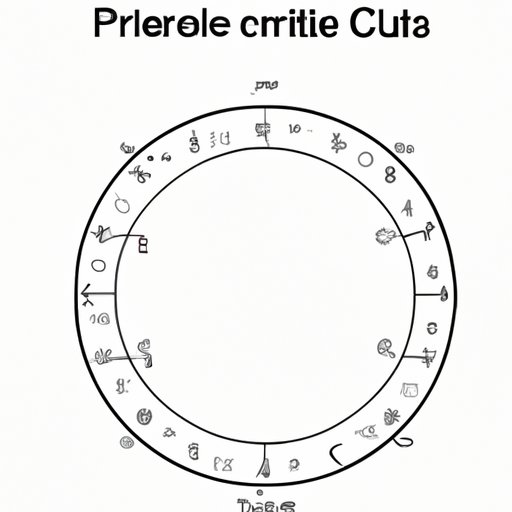
I. Introduction
Are you trying to improve your math skills? Do you struggle with finding the perimeter of a circle? In this comprehensive guide, we will explore the basics of circle perimeters, different formulas that can be used, and expert tips and techniques for accurate calculation.
Knowing how to find the perimeter of a circle is essential for a variety of fields such as engineering, architecture, and science. Understanding circle perimeters will give you an edge in these areas and help you solve problems involving circles more efficiently.
II. Mastering the Basics: How to Find the Perimeter of a Circle
Before we delve into more advanced techniques, it’s important to know the basics of finding a circle’s perimeter. The perimeter of a circle is the distance around its edge, also known as the circumference. A circle is a two-dimensional shape with all points equidistant from its center point.
To calculate the perimeter of a circle, you can use the formula P = 2πr, where P is the perimeter (circumference), π is a mathematical constant approximately equal to 3.14159, and r is the radius, which is the distance from the center of the circle to its edge.
III. Discovering Pi: A Beginner’s Guide to Calculating Circle Perimeters
Now that we know the basics, let’s learn more about pi. Pi is a mathematical constant that represents the ratio of a circle’s circumference to its diameter. It is an irrational number, meaning it cannot be expressed as a fraction and has an infinite number of decimal places.
The value of pi is approximately 3.14159, and it plays a significant role in calculating circle perimeters. To find the perimeter of a circle using pi, you can use the formula P = πd, where P is the perimeter and d is the diameter, which is the distance across the circle through its center point.
For example, if a circle has a diameter of 10 cm, its perimeter would be P = πd = π x 10 cm = 31.4 cm.
IV. Exploring Circles: Methods for Finding Perimeters
While the formula P = 2πr and P = πd are the most commonly used methods for finding circle perimeters, there are additional formulas that can be used for specific scenarios. For instance, to find the area of a sector or segment of a circle, you might use a more complex formula that takes into account the central angle and radius.
It’s important to understand each formula’s purpose and when it should be used to accurately calculate a circle’s perimeter. Remember that the more complex the formula, the more opportunities for mistakes in calculation, so be sure to double-check your work.
V. Math Made Simple: Step-by-Step Guide to Finding Circle Perimeters
To make finding circle perimeters even easier, we’ve outlined a step-by-step process:
- Identify the given information, such as the radius or diameter.
- Determine which formula to use based on the information given.
- Substitute the values into the formula.
- Calculate the perimeter using simple arithmetic operations (multiplication and addition).
- Round your answer to the appropriate level of accuracy.
It’s helpful to use visual aids such as diagrams or graphs to better understand the process and identify any mistakes in calculation. Practicing with different examples will also help you gain confidence in your ability to find circle perimeters.
VI. The Expert’s Guide to Calculating Circle Perimeters
If you’re looking to take your circle perimeter skills to the next level, here are a few expert tips:
- Break down complex problems into smaller parts for easier calculation.
- Use different units of measurement, such as centimeters or inches, to help you visualize the problem and identify errors.
- Round your answers to the appropriate level of accuracy based on the given information to avoid overestimations or underestimations.
- Double-check your work and make sure your calculations are correct before submitting or presenting them.
By following these tips and continuing to practice, you can become an expert at finding circle perimeters.
VII. Circle Perimeters Unveiled: Tips and Techniques for Accurate Calculation
It’s easy to make mistakes when finding a circle’s perimeter, especially when dealing with complex formulas or large numbers. Here are some tips and techniques to avoid common mistakes:
- Double-check your calculations, especially when using more complex formulas that involve fractions or decimals.
- Use a calculator or computer program to reduce the likelihood of errors due to human calculation.
- Label your work and write out the formulas used to make it clear and easier to follow.
- Practice regularly and work with a tutor or mentor to identify and correct any mistakes or areas of confusion.
By following these tips and techniques, you can become an expert at calculating circle perimeters with greater accuracy and efficiency.
VIII. From Diameters to Perimeters: How to Find the Total Distance Around a Circle
Diameters and perimeters are closely related in circle math. In fact, you can find the perimeter of a circle using its diameter. To do so, simply use the formula P = πd, where P is the perimeter and d is the diameter.
For example, if a circle has a diameter of 20 cm, its perimeter would be P = πd = π x 20 cm = 62.8 cm.
Whether you’re working with diameters or perimeters, understanding the relationship between these two metrics is essential in finding accurate answers to circle problems.
IX. Conclusion
Calculating circle perimeters may seem daunting at first, but with practice and an understanding of the different formulas and techniques available, it can become second nature. Remember to double-check your work, use visual aids, and seek help when needed. By mastering circle perimeters, you’ll not only improve your math skills but also gain an edge in many fields that rely on circle calculations.




